During their time in the womb, babies thrive in a warm, comfortable and safe environment. They know nothing of bright lights, separation from their mother or temperature changes. For these reasons and many more, babies feel most safe and secure when they are being held by their parents.
Baby wearing supports this secure environment and provides comfort to both mother and baby. But what are the benefits and risks of baby wearing?
Benefits:
- When you carried your baby in your womb, you were constantly moving during the day. This is often the time your baby would sleep, as the movement soothed them. So, the gentle swaying/rocking movement of being in a carrier can help calm your baby and remind them of their first home.
- Holding your close to your chest they can listen to the sounds of your heartbeat and body, a sound they are very accustomed to!
- Babies spend 9 months in a confined environment. They are unfamiliar with wide open spaces and room to move around. Tucking them in closely, with their limbs tucked in appropriately helps them feel safe, and secure.
- Bonding and attachment. Baby wearing can support the bond you have with you have with your baby as it stimulates the release of oxytocin (our ‘love’ hormone). This works for mothers and fathers alike!
- Less crying. Baby wearing helps to reduce newborn stress and crying.
- Helps promote neck strength and head control.
- Supports breastfeeding due to oxytocin release and responsiveness to feeding cues
- Convenient – especially when baby wearing is the only way to help your baby to settle and you have other household tasks/children to attend to.
Risks:
- Extensive baby wearing can eventually lead to a strained back, shoulders or neck. This can contribute to headaches and poor sleep.
- Abdominal separation can be worsened by the strain of baby carriers if they are not correctly adjusted around your waist.
- Check your baby’s airway is safe. Your baby should not have their chin tucked into their chest, this can block their airway and is extremely dangerous.
- Avoid hip dysplasia from poorly made baby carriers. Your baby needs a baby carrier wide enough to support appropriate hip placement and leg extension.
If you are considering the purchase of a baby carrier for regular use its important to keep this in mind and ensure the carrier is correctly made.
Safety precautions:
- Follow the recommended weight guide for use of baby carriers and do not use on premature or low weight babies.
- Your baby needs to be in view at all times and ensure their head is tucked up, airway not obstructed. They will need to have a supported back so that when they sleep, they will not slip down or curl up, risking their airway.
- Be mindful during warm weather months and not allowing your baby to overheat when pressed against you.
- Always follow the manufactures instructions for use to ensure your baby is positioned appropriately and safety at all times.
Written by Keryn Thompson RM & IBCLC (L-301766)
References:
Grisham, L. M., Rankin, L., Maurer, J. A., Gephart, S. M., & Bell, A. (2023). Scoping Review of Biological and Behavioral Effects of Babywearing on Mothers and Infants. Journal of Obstetric, Gynecologic & Neonatal Nursing. https://doi.org/10.1016/j.jogn.2022.12.008
Hallenbeck, S. (2018). Mobility, Moms, and the Babywearing Phenomenon. Women's Studies in Communication, 41(4), 359–369. https://doi.org/10.1080/07491409.2018.1551681
Reynolds-Miller, R. L. (2016). Potential Therapeutic Benefits of Babywearing. Creative Nursing, 22(1), 17–23. https://doi.org/10.1891/1078-4535.22.1.17
Sidharthan, S., Kehoe, C., & Dodwell, E. (2020). Post-Natal Positioning through Babywearing: What the Orthopaedic Surgeon Needs to Know. Journal of the Pediatric Orthopaedic Society of North America, 2(3). https://doi.org/10.55275/jposna-2020-131
Vaidya, S., Aroojis, A., & Mehta, R. (2021). Developmental Dysplasia of Hip and Post-natal Positioning: Role of Swaddling and Baby-Wearing. Indian Journal of Orthopaedics. https://doi.org/10.1007/s43465-021-00513-3
Williams, L., Standifird, T., & Madsen, M. (2019). Effects of infant transportation on lower extremity joint moments: Baby carrier versus carrying in-arms. Gait & Posture, 70, 168–174. https://doi.org/10.1016/j.gaitpost.2019.02.004
Williams, L. R., & Turner, P. R. (2020). Infant carrying as a tool to promote secure attachments in young mothers: Comparing intervention and control infants during the still-face paradigm. Infant Behaviour and Development, 58, 101413. https://doi.org/10.1016/j.infbeh.2019.101413



